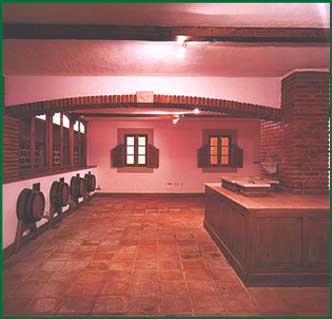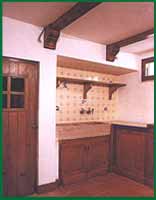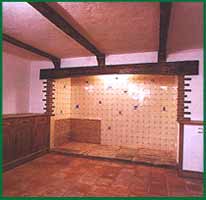|
 |

|
 |

Only then could we
apply the old stone sink, coming from a demolition, over a normal cupboard,
where before there was only an azulejos lining. And another one, in the
previous corner where the dishwasher was hidden. False cupboards were fixed
to hide console brackets holding the house structure. At first, the barrel
tops were only ornamental, but with some skill it was possible to create
inox barrels behind - enclosed within the console brackets - with around
15 litre wine containers. The barrel bases were used to put a counter with
a cupboard for china on top. Very different from the previous wine cellar,
surrounded by uncharacteristic azulejos. |

|
Using
once again the console brackets, a new counter was created including a sink.
The previous counter was just a small rectangle to put for instance a cheese
tray or some large bottles of wine. The stones now used in this sink were
aged so as to look rustic. All taps are old and were purchased in Feira
da Ladra being then carefully cleaned. The ornamental old ring to held harnesses
and the original stone spout are also old. The bricks and pavement tiles
are all handmade. |
The
two arcs ornamentally enhance the use of the structural beams. They were
covered with tijolo-burro (thick and compact bricks), presenting a closing
stone created on purpose, after being aged. These beams used to be cold
and skeletal. The ceiling and wall were coated with plaster using traditional
lime mortar. But the beams are not just ornamental, as they also hide the
electrical cables that were all replaced.
|

|
The
small windows at the level of the outside pavement remained as they were
but two others were enlarged on the concrete wall, a little bit further,
so the wine cellar would have more light. A typical Alentejo chimney was
recreated with its small fire corner, and true old flagstone floor in the
inside. The hand painted azulejos have the old shape 14x14 and although
recent they were handmade.
From the outside nobody will tell there is
a wine cellar behind the normal door. But this door opens to another door
- a typical Portuguese door - forming a kind of double entrance. Only then
the scenery is complete. |
 |

(C)2002 Paulo Jones Lda

|
|
"Arquitectura & Construção" Magazine
Photographer José Miguel Figueiredo
|
|
|


